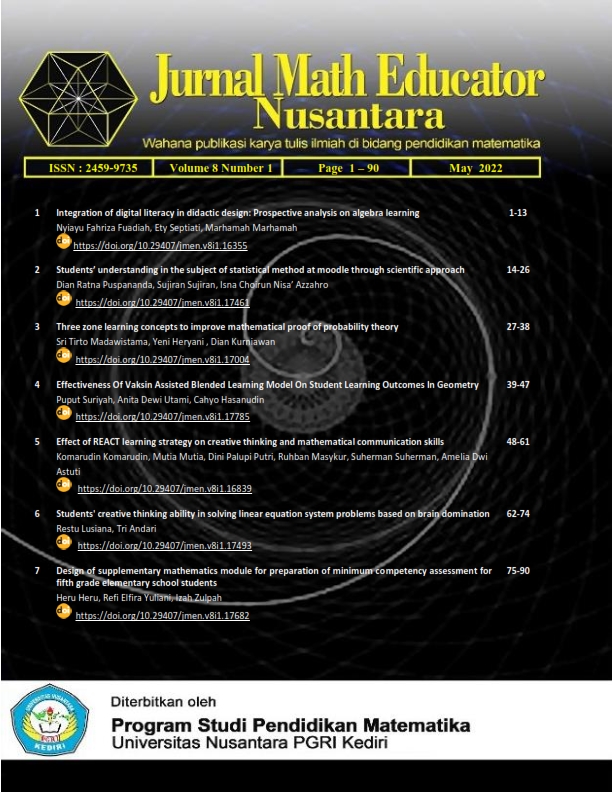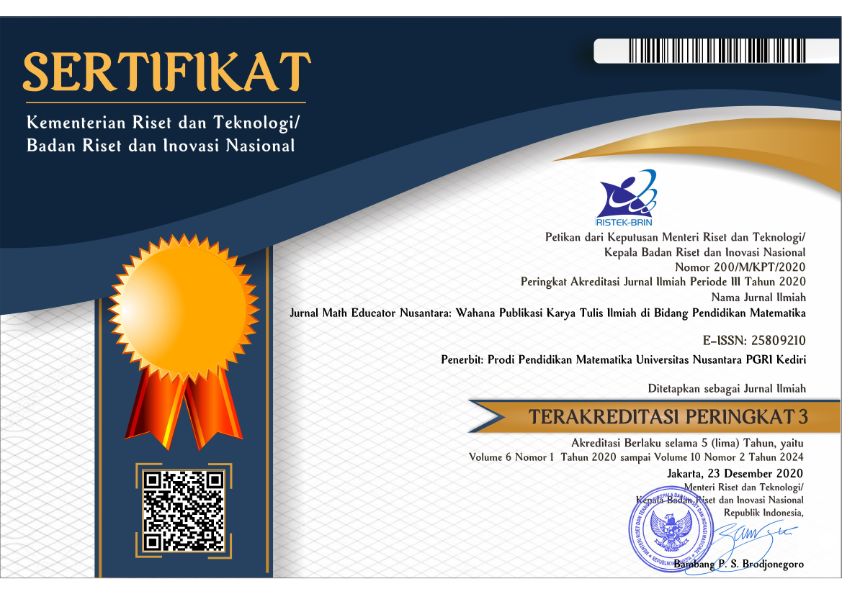Effectiveness Of Vaksin Assisted Blended Learning Model On Student Learning Outcomes In Geometry
DOI:
https://doi.org/10.29407/jmen.v8i1.17785Keywords:
VAKSIN Assisted Blended Learning Model, Learning Outcomes, GeometryAbstract
The purpose of this study was to prove whether the blended learning model assisted by VAKSIN (Video Animasi untuk Sistem Pembelajaran Online/Video Animation for Online Learning Systems) is more effective than the online learning model on student learning outcomes in the fourth semester of the Mathematics Education Study Program. The posttest only control design was carried out in the Geometry course at IKIP PGRI Bojonegoro for the 2021/2022 academic year. This study used a saturated sampling technique where all members of the population are used as samples. Data collection techniques in this study used documentation and test techniques. Test the hypothesis used t-test. The results of data analysis obtained by testing the hypothesis in the experimental class and control obtained tcount= 3,18219098 dengan ttable = 1,99084707. Karena tcount > ttable hence H0 is rejected so it can be concluded that the learning outcomes of the fourth semester students of the Mathematics Education Study Program of IKIP PGRI Bojonegoro who were subjected to VAKSIN-assisted blended learning were more effective than those who were subjected to online learning.
References
Abar CAAP & Carnevale d MU. (2019). Flipped Classrooms and MOODLE: Digital Technologies to Support Teaching and Learning Mathematics. Act Dida Napoc. 12(2): 209-16. https://doi.org/10.24193/adn.1 2.2.16
Amiroh. (2012). Membangun e-learning dengan learning management system moodle ver. 2. Sidoharjo: Genta Group Production.
Baety DN & Munandar DR. (2021). analisis efektifitas pembelajaran daring dalam menghadapi wabah pandemi covid-19. Edu: J Ilm Pen. 3(3): 880-9. https://doi.org/10.31004/edukatif.v3i3.476
Budiyono. (2009). Statistika untuk Penelitian. Surakarta: UNS Press
Budiyono. 2003. Metodologi Penelitian Pendidikan. Surakarta: Sebelas Maret University Press
Dwiyogo. (2016). Pembelajaran berbasis learning (model pembelajaran). Malang: Wineka Media.
Fauzi I & Arisetyawan A. (2020). Analisis kesulitan belajar siswa pada materi geometri di sekolah dasar. Krea, J Mat Krea-Inov.11(1): 27-5. https://doi.org/10.15294/kreano.v11i1.20726
Folden RW (2012). Higher education institutions and learning management systems: adoption and standardization. Edited by Rosalina Babo and Ana Azevedo. USA: IZI Global
Hasanudin C., Supriyanto RT, & Pristiwati R. (2020). Elaborasi model pembelajaran flipped classroom dan google classroom sebagai bentuk self-development siswa mengikuti pembelajaran bahasa Indonesia di era Adaptasi Kebiasaan Baru (AKB). Intel: J Pend Islam. 8(2): 85-7. https://doi.org/10.34001/intelegensia.v8i2.1414
Hidayati PI (2016). Optimalisasi pengembangan blended learning berbasis moodle untuk matakuliah mikrobiologi optimization development based blended learning moodle course for microbiology. J Ins Pend. 6(2): 890-7. https://doi.org/10.21067/jip.v6i2.1328
Hofmann J. (2001) Blended learning case study. Available at www.learningcircuits.org
Hollebrands KF. (2003). High school students’ understandings of geometric transformations in the context of a technological environment. The J of Math Beh. 22(1): 55-72. https://doi.org/10.1016/S0732-3123(03)00004-X
Jannah R & Santoso H. (2021). Tingkat stres mahasiswa mengikuti pembelajaran daring pada masa pandemi covid-19. J Ris dan Peng Mas. 1(1), 130-6. https://doi.org/10.22373/jrpm.v1i1.638
Jatmika D. (2020). Webinar growth-mindset untuk pembelajaran online pada siswa SMA di Samarinda. Alt: J of Com Ser. 1(4): 188-3.
Jupri A. (2017). From geometry to algebra and vice versa: Realistic mathematics education principles for analyzing geometry tasks. In AIP Conf Proc. 1830(1): 050001-010. https://doi.org/10.1063/1.4980938
Khasanah DRAU, Pramudibyanto H, & Widuroyekti B. (2020). Pendidikan dalam masa pandemi covid-19. J Sin. 10(1): 41–8. Available at https://sinestesia.pustaka.my.id/journal/article/view/44
Kholisho YN & Marfuatun. (2020). Daya serap pelaksanaan mata kuliah kependidikan di tengah pandemi covid-19. Edu: J Pen Infor. 4(1): 131-0. https://doi.org/10.29408/edumatic.v4i1.2155
Kusmaharti D. (2021). Efektivitas pembelajaran matematika secara daring: studi kasus pada mahasiswa pgsd saat pandemi covid-19. Elem Sch: J Pend dan Pem ke-SD-an. 8(2): 252-8. https://doi.org/10.31316/esjurnal.v8i2.1263
Munir. (2012). Pembelajaran jarak jauh. Bandung: Alfabeta.
Murti AHD, Arsal AF, & Muis A. (2021). Analisis kesulitan belajar siswa aspek motivasi belajar dan kondisi kesehatan fisik pada pembelajaran daring mata pelajaran biologi kelas xi SMA Negeri 06 Makassar. Bio Teac and Lear, 4(1): 35-3. https://doi.org/10.35580/btl.v4i1.21591
Pratiwi IR & Silalahi P. (2021). Pengembangan Media pembelajaran metematika model blended learning berbasi moodle. AKS: J Prog Stu Pend Mat. 10(1); 206-8. Available at https://scholar.archive.org/work/ffocij4mg5dl7jvrmjhsroq6k4/access/wayback/https://ojs.fkip.ummetro.ac.id/index.php/matematika/article/download/3240/pdf
Pratiwi YI, Budiharti R, & Ekawati EY. (2014). Pengembangan media pembelajaran IPA terpadu interaktif dalam bentuk moodle untuk siswa smp pada tema matahari sebagai sumber energi alternatif. J Pend Fis. 2(1). 26-0. Available at https://jurnal.fkip.uns.ac.id/index.php/pfisika/article/view/3732
Putra EA, Sudiana R, & Pamungkas AS. (2020). Pengembangan Smartphone Learning Management System (S-LMS) sebagai media pembelajaran matematika di SMA. Krea, J Mat Krea-Inov. 11(1): 36–5. https://doi.org/10.15294/kreano.v11i1.21014
Sadikin A & Hamidah A. (2020). Pembelajaran daring di tengah wabah covid-19 (online learning in the middle of the covid-19 pandemic). Biod. 6(2): 214-4. Available at https://repository.unja.ac.id/15758/
Saifuddin MF. (2018). E-learning dalam persepsi mahasiswa. J VAR. 29(2): 102–9. https://doi.org/10.23917/varidika.v29i2.5637
Santagata R dan Guarino J. (2011). Using video to teach future teachers to learn fromteaching. ZDM Math Edu. 43(1):133–5. Available at https://link.springer.com/article/10.1007/s11858-010-0292-3
Seah R. (2015). Reasoning with geometric shapes. Aus Math Teac. 71(2): 4-11. Available at https://eric.ed.gov/?id=EJ1093213
Suriyah, P., Zainudin, M., & Yektiana, S. (2021). Pedagogical compentence of mathematics education lectures using LMS (Learning Management System) moodle in the era Covid-19. Jurnal Math Educator Nusantara, 7(1): 64-80. Available at https://ojs.unpkediri.ac.id/index.php/matematika/article/view/15847.
Syahringsih & Adnan (2018). Analisis kebutuhan pengembangan media pembelajaran e-learning berbasis moodle di SMA. In Seminar Nasional Biologi. Available at http://103.76.50.195/semnasbio/article/view/7220
Wardani DN, Toenlioe AJ, & Wedi A. (2018). Daya tarik pembelajaran di era 21 dengan blended learning. J Kaj Tek Pend. 1(1): 13-8. Available at http://journal2.um.ac.id/index.php/jktp/article/view/2852
Whitelock D. & Jelfs A. (2003) Editorial: Journal of Educational Media Special Issue on Blended Learning. J of Edu Med. 28(2-3): 99-00.
Zhafira NH, Ertika Y, & Chairiyaton. (2020). Persepsi mahasiswa terhadap perkuliahan daring sebagai sarana pembelajaran. J Bisn Dan Kaj Stra Manaj. 4(1): 37–5. https://doi.org/10.35308/jbkan.v4i1.1981
Downloads
Published
Issue
Section
License
Authors who publish with this journal agree to the following terms:
- Copyright on any article is retained by the author(s).
- The author grants the journal, the right of first publication with the work simultaneously licensed under a Creative Commons Attribution License that allows others to share the work with an acknowledgment of the work’s authorship and initial publication in this journal.
- Authors are able to enter into separate, additional contractual arrangements for the non-exclusive distribution of the journal’s published version of the work (e.g., post it to an institutional repository or publish it in a book), with an acknowledgment of its initial publication in this journal.
- Authors are permitted and encouraged to post their work online (e.g., in institutional repositories or on their website) prior to and during the submission process, as it can lead to productive exchanges, as well as earlier and greater citation of published work.
- The article and any associated published material is distributed under the Creative Commons Attribution-ShareAlike 4.0 International License
















